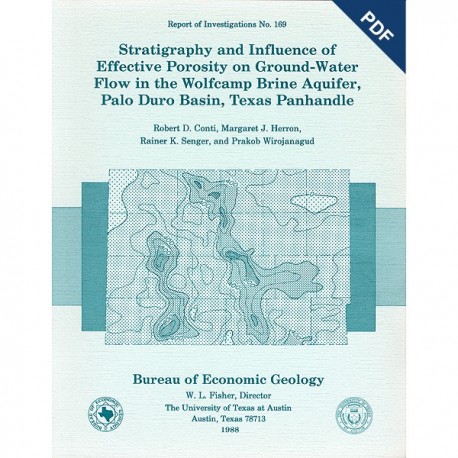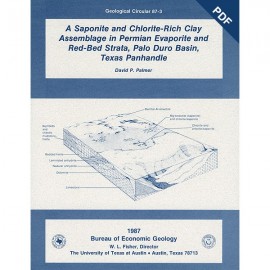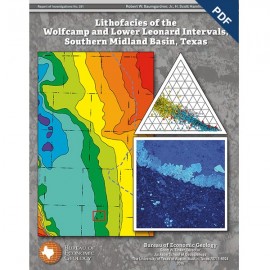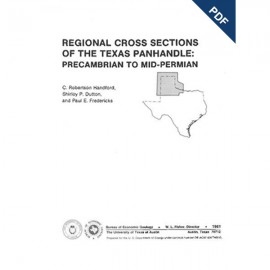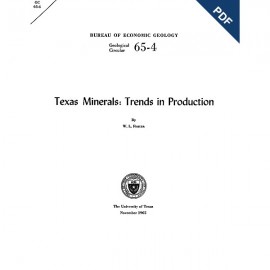Reports of Investigations
-
Books & Reports
- Reports of Investigations
- Guidebooks
- Udden Series
- Geological Circulars
- Down To Earth
- Atlases of Major Oil and Gas Reservoirs
- Texas Memorial Museum Publications
- Environmental Geologic Atlas of the Texas Coastal Zone
- Mineral Resource Circulars
- Other Reports
- Seminars and Workshops
- Handbooks
- Submerged Lands of Texas
- Symposia
- Annual Reports
- Open File Reports
-
Maps & Cross Sections
- Thematic Maps
- Miscellaneous Maps, Charts & Sections
- Geologic Atlas of Texas
- STATEMAP Project Maps
- Geologic Quadrangle Maps
- Cross Sections
- Highway Geology Map
- Energy and Mineral Resource Maps
- Shoreline Change and Other Posters
- Wilcox Group, East Texas, Geological / Hydrological Folios
- Bouguer Gravity Atlas of Texas
- River Basin Regional Studies
- Featured Maps
- Posters
- Teachers & the Public
-
Geological Society Publications
- Gulf Coast Association of Geological Societies
- Alabama Geological Society
- Austin Geological Society
- Corpus Christi Geological Society
- Houston Geological Society
- Lafayette Geological Society
- Mississippi Geological Society
- New Orleans Geological Society
- South Texas Geological Society
- GCS SEPM Publications
- Historic BEG & UT Series
Stratigraphy and ...Ground-Water Flow...Wolfcamp Brine Aquifer, Palo Duro Basin... Digital Download
RI0169D
For a print version: RI0169.
RI0169D. Stratigraphy and Influence of Effective Porosity on Ground-Water Flow in the Wolfcamp Brine Aquifer, Palo Duro Basin, Texas Panhandle, by R. D. Conti, M. J. Herron, R. K. Senger, and Prakob Wirojanagud. 44 p., 31 figs., 2 tables, 3 appendices, 1988. doi.org/10.23867/RI0169D. Downloadable PDF.
To purchase this publication in book format, please order RI0169.
ABSTRACT
In the Palo Duro Basin, the Wolfcampian Series (lower Permian) overlies Pennsylvanian (primarily Virgilian) strata and underlies the Wichita Group (Leonardian). Tectonic activity from late Pennsylvanian through early Wolfcampian deposition included basement subsidence that resulted in localized basin development. The basin evolved into a restricted, shallow-marine, evaporitic environment that prograded southward, resulting in deposition throughout most of the basin of evaporite and red-bed sediments of Leonardian age and younger.
The Pennsylvanian-Wolfcampian contact is mostly conformable, but a few erosional unconformities or depositional hiatuses occur in peripheral areas of the basin. The upper Wolfcamp-Wichita lithologic boundary is time-transgressive, conformable throughout the basin, and marked in geophysical well logs by responses that indicate a downward change in lithology from a low-porosity dolomite/anhydritic dolomite to a high-porosity granular dolomite.
Lower Wolfcamp lithofacies consist of shales, shallow-marine carbonates, and deltaic sands. Upper Wolfcamp lithofacies are primarily shallow-shelf carbonates, but the uppermost facies, the Brown Dolomite, reflects basinwide dolomitization of carbonates deposited in the late Wolfcampian.
The predominantly carbonate Deep-Basin Brine aquifer in the Wolfcampian Series lies 2,100 to 3,100 ft (640 to 945 m) beneath bedded San Andres (Guadalupian) salt, a potential host rock for isolated high-level nuclear waste. Knowing effective-porosity distributions within the Deep- Basin Brine aquifer is therefore important for estimating ground-water flow velocities and the frequency of basin flushing. Maps of effective-porosity distribution generated in this study are based on cross-plotted neutron-density log responses.
In the lower Wolfcamp, effective porosity is highest in coarse sands and granite-wash sediments adjacent to the Amarillo Uplift and the Bravo Dome and in thin carbonate units throughout the basin. In the uppermost Wolfcamp, the Brown Dolomite is basically a diagenetic unit characterized by dolomite lithology and relatively high effective porosity. The Brown Dolomite is a hydrocarbon reservoir in areas peripheral to the basin; it is also the upper part of the Deep-Basin Brine aquifer system, which extends throughout the Palo Duro Basin. The axes of thickening and relatively high effective porosity in the Brown Dolomite coincide with the early Wolfcampian shelf-margin positions and associated carbonate buildups. The Brown Dolomite thins basinward, where relatively low effective porosity developed, and landward, where clastic sedimentation prevailed until the late Wolfcampian.
Integrity of a geologic containment system at a potential repository site depends on hydrologic conditions and the local resource potential of the site. In this study, therefore, mapped effective-porosity distributions are used to (1) define porosity fairways and their relation to Wolfcampian shelf-margin positions, major lithofacies, and zones of diagenesis; (2) refine ground-water travel-time estimates; and (3) provide a foundation for estimating total effective pore volume, which equals the quantity of mobile fluids.
Average frequency of basin flushing (measurements taken from the middle of the basin) is estimated to be once every 2.0 m.y. by a typical effective-porosity model and once every 1.2 m.y. by a log-derived effective-porosity flow model. Planimetry-based analyses of log-derived effective-porosity distributions show that total effective pore volume is 2.9 x 1013ft3 (8.2 x 1011 m3).
Keywords: Brown Dolomite, Deep-Basin Brine aquifer, effective-porosity distribution, geophysical log cross plotting, ground-water flow velocities, Palo Duro Basin, stratigraphy, Wolfcampian
CONTENTS
ABSTRACT
INTRODUCTION
WOLFCAMPIAN
Tectonics and sedimentation
Paleogeography
Pennsylvanian-Permian boundary
Lower Wolfcamp strata
Wolfcamp-Wichita boundary
Stratigraphy of the Brown Dolomite
WOLFCAMP POROSITY
Comparison of core data with log data
Average effective-porosity distribution
Hydrologic implications
Applied average effective-porosity distribution in areal ground-water flow simulation
Detailed effective-porosity-range distribution
Wolfcampian Series
Brown Dolomite
Thickness and effective-porosity trends in the Brown Dolomite
CONCLUSIONS
ACKNOWLEDGMENTS
REFERENCES
APPENDIX A. Relation of permeability to effective porosity
APPENDIX B. Comparison of effective porosity derived from cross-plotted neutron-density responses with effective porosity derived from core-plug analysis
APPENDIX C. Estimating total effective porosity
FIGURES
1. Index map showing structural elements of Texas Panhandle and surrounding areas
2. Stratigraphic correlation chart for units of lower Permian and Pennsylvanian Systems in western Oklahoma and the Anadarko, Palo Duro, and northern Midland Basins
3. Paleogeographic evolution of the Palo Duro Basin during early Permian time
4. Lithofacies of uppermost Pennsylvanian strata interpreted from sample and geophysical logs
5. Lithofacies of lower Wolfcamp strata interpreted from sample and geophysical logs
6. East-west cross section illustrating the Pennsylvanian-Permian boundary, Palo Duro Basin, and relationships between the Wolfcamp and older strata
7. Thickness of the lower Wolfcamp terrigenous elastic-dominated section
8. Distribution of sandstone or granite wash or both having a net thickness of 50 ft (15 m) or greater in Wolfcamp strata
9. Typical log responses at the Wolfcamp-Wichita boundary
10. Percent anhydrite in the Wichita Group
11. Lithofacies map of Wichita Group (lower Leonardian)
12. North-south cross section illustrating the Pennsylvanian-Permian boundary, Palo Duro Basin, and relationships between the Wolfcamp and older strata
13. Representative core of the Brown Dolomite (upper Wolfcamp) showing nodular anhydrite
14. Representative core of the Brown Dolomite (upper Wolfcamp) showing dolomitic pisolite
15. Anhedral dolomite with intercrystalline porosity
16. Areal extent and isopach map of Brown Dolomite or its equivalent, the Herington Dolomite, in the Texas Panhandle
17. Representative lithology-porosity columns constructed from cross-plotted neutron-porosity and density-porosity log responses
18. Schematic cross sections showing the relationship of thickened Brown Dolomite to eastern and western early Wolfcampian shelf-margin positions
Citation
Conti, R. D., Herron, M. J., Senger, R. K., and Wirojanagud, Prakob, 1988, Stratigraphy and Influence of Effective Porosity on Ground-Water Flow in the Wolfcamp Brine Aquifer, Palo Duro Basin, Texas Panhandle: The University of Texas at Austin, Bureau of Economic Geology, Report of Investigations No. 169, 44 p.
